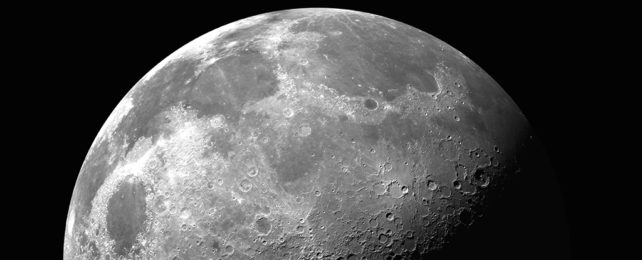Scientists are continuing to analyze samples of rock and dirt brought back by China's Chang'e 5 lunar rover, and the latest results point to new kinds of geology from regions of the Moon that are yet to be discovered and explored.
Seven different types of rock were identified among 1.731 kilograms (3.816 pounds) of 2 billion-year-old regolith – the loose, crumbly dirt and rubble on the Moon's surface. One of the rocks is a completely new type of lunar basalt, created at a time when the Moon was still volcanically active.
This regolith is the youngest to be brought back from the Moon so far, giving experts a look into a different time period than other samples, and helping them chart a tumultuous period of our close neighbor's history.
The seven types of rock listed in the study are all considered 'exotic', thought to have reached their current landing site from somewhere else.
"In such a young geological unit, a wide range of crustal components from various sources would be transported to the Chang'e-5 landing site by the latter ongoing surface processes on the Moon," write the researchers in their published paper.
Some 3,000 particles less than 2 millimeters (0.08 inches) in size were sifted through by the researchers, as they looked for evidence of past impact cratering and volcanic activity. As on Earth, these types of igneous rocks can tell a geological tale.
Three of the clasts were notable for showing unusual petrological and compositional features, the researchers say. The high-Ti vitrophyric fragment – high in titanium, with larger crystals embedded in a glassy rock – has a mineralogy we haven't seen before on the Moon, and probably represents a new type of lunar rock.
According to the study's authors, these rock particles may be associated with sites on the Moon up to 400 kilometers (249 miles) away from where they were picked up, blasted across the surface by a succession of asteroid impacts over the millennia.
"These exotic igneous clasts would record the lithological diversity and regolith gardening processes at the [roughly 2 billion year old] young mare regions of the Moon," write the researchers.
Put all of this together, and the conclusion is that these fragments have come from parts of the Moon's surface that we don't yet know about, in geological terms. There might even have been volcanic eruptions that we don't yet know about.
However, only around 0.2 percent of the material in the samples was classified as exotic, rather than the expected 10-20 percent. That suggests that scientists may have to rethink the way that impact ejecta travels on the lunar surface, at least in this newer region.
Chang'e 5 collected its samples in the Mons Rümker region of the northern Oceanus Procellarum of the Moon, and further samples – as well as existing ones from earlier missions – will be helpful in learning more about how the lunar surface evolved, and where future landing and base sites should be situated.
The research has been published in Nature Astronomy.
